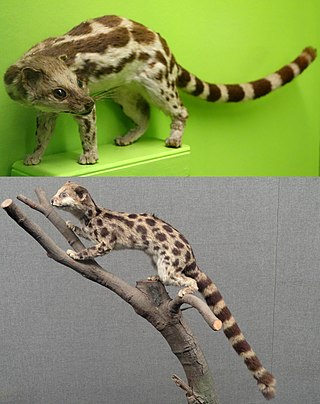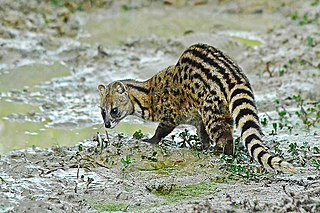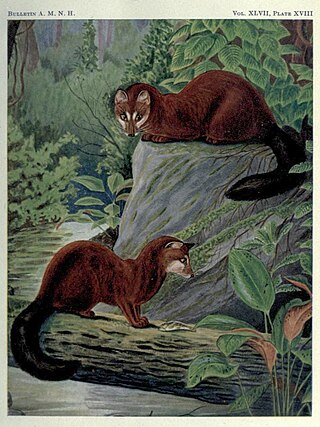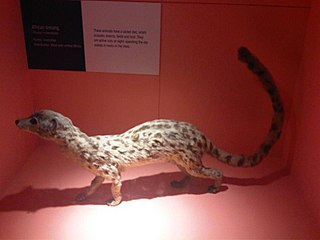
Viverridae is a family of small to medium-sized, feliform mammals. The viverrids comprise 33 species placed in 14 genera. This family was named and first described by John Edward Gray in 1821. Viverrids occur all over Africa, southern Europe, and South and Southeast Asia, across the Wallace Line.

The African golden cat is a wild cat endemic to the rainforests of West and Central Africa. It is threatened due to deforestation and bushmeat hunting and listed as Vulnerable on the IUCN Red List. It is a close relative of both the caracal and the serval. Previously, it was placed in the genus Profelis. Its body size ranges from 61 to 101 cm with a 16 to 46 cm long tail.

The honey badger, also known as the ratel, is a mammal widely distributed in Africa, Southwest Asia, and the Indian subcontinent. Because of its wide range and occurrence in a variety of habitats, it is listed as Least Concern on the IUCN Red List.

The Asiatic linsang (Prionodon) is a genus comprising two species native to Southeast Asia: the banded linsang and the spotted linsang. Prionodon is considered a sister taxon of the Felidae.

The African civet is a large viverrid native to sub-Saharan Africa, where it is considered common and widely distributed in woodlands and secondary forests. It is listed as Least Concern on the IUCN Red List since 2008. In some countries, it is threatened by hunting, and wild-caught individuals are kept for producing civetone for the perfume industry.

The spotted linsang is a linsang, a tree-dwelling carnivorous mammal, native to much of Southeast Asia. It is widely, though usually sparsely, recorded, and listed as Least Concern on the IUCN Red List.

The African leopard is the nominate subspecies of the leopard, native to many countries in Africa. It is widely distributed in most of sub-Saharan Africa, but the historical range has been fragmented in the course of habitat conversion. Leopards have also been recorded in North Africa as well.

The small Indian civet is a civet native to South and Southeast Asia. It is listed as Least Concern on the IUCN Red List because of its widespread distribution, widespread habitat use and healthy populations living in agricultural and secondary landscapes of many range states.

A genet is a member of the genus Genetta, which consists of 17 species of small African carnivorans. The common genet is the only genet present in Europe and occurs in the Iberian Peninsula, Italy and France.

The servaline genet is a genet species native to Central Africa. As it is widely distributed and considered common, it is listed as Least Concern on the IUCN Red List.

The aquatic genet, also known as the fishing genet, is a genet that has only been recorded in the northeast of the Democratic Republic of the Congo. Since it is only known from about 30 specimens in zoological collections, it had been listed as Data Deficient on the IUCN Red List since 1996, as it is considered one of Africa's rarest carnivores. In 2015, it has been reassessed as Near Threatened.

The rusty-spotted genet, also called panther genet and large-spotted genet, is a genet that is widely distributed in sub-Saharan Africa. It is considered common and therefore listed as Least Concern on the IUCN Red List.

Johnston's genet is a genet species native to the Upper Guinean forests. As it is threatened by deforestation and conversion of rainforest to agriculturally and industrially used land, it is listed as Near Threatened on the IUCN Red List.

The West African oyan, also known as the West African linsang, is a linsang species native to the Upper Guinean forests in West Africa. It is one of the least known small carnivores in Africa.

The Viverrinae represent the largest subfamily of the Viverridae comprising three genera, which are subdivided into six species native to Africa and Southeast Asia. This subfamily was denominated and first described by John Edward Gray in 1864.

The Gabon bushbaby is a species of primate in the family Galagidae found in Cameroon, Gabon, and the Republic of the Congo. Its head and body length is 8.5 in with a 10-in tail, and it weighs about 10 oz. It lives in evergreen tropical rainforests and eats primarily fallen fruit, but also some arthropods.

The African linsangs also known as oyans are two species classified in the mammalian subfamily Viverrinae, in the family Viverridae. There is one genus, Poiana.

The linsangs are four species of tree-dwelling carnivorous mammals. The name of these species originated in the Javanese language as linsang or wlinsang, and previously, was translated incorrectly in English dictionaries as "otter". The two African species belong to the family Viverridae and the two Asiatic species belong to the family Prionodontidae. Formerly, both linsang genera were placed in the subfamily Viverrinae, along with several other genera, but recent research suggests that their relationships may be somewhat different.

Genettinae is a subfamily of the feliform viverrids. It contains all of the genet species and the oyan species.




















